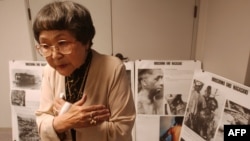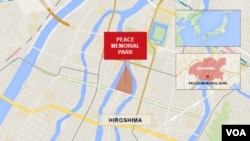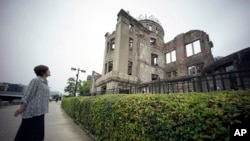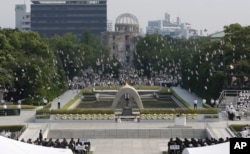When U.S. President Barack Obama visits Hiroshima later this month, some survivors of the world’s first atomic attack hope he will officially acknowledge the devastating loss and suffering caused by America’s use of nuclear weapons on Japan at the end of World War II.
The visit, the first by a sitting U.S. president, will help Obama advance some important policy initiatives, such as preventing the spread of weapons of mass destruction, and maintaining strong international pressure on North Korea to end its nuclear weapons program.
But for the survivors, some hope for an official apology. White House has indicated that is not in the plans. Others would like him to express grief and seek reconciliation.
“Before I die I want to see the president, the sitting president’s face. That is not for asking for an apology. No, just as a human being. You are here and we are standing on the same land, the same level land and then pray for the dead,” said Keiko Ogura, a Hiroshima atomic bomb survivor who is now 79 years old.
Hiroshima debate
On August 6, 1945, the United States dropped the world’s first atomic bomb on Hiroshima, killing around 140,000 people, including those that died later from intense radiation exposure.
No U.S. president has ever visited Hiroshima while still in office.
America's use of nuclear weapons at Hiroshima and Nagasaki to hasten Japan’s unconditional surrender in World War II remains a controversial issue. From the perspective of the victors, the atomic bombs saved the lives of many American troops as well as Japanese by bringing an early end to the war.
But they also killed thousands of innocent civilians. Hiroshima was reportedly chosen as the target site for the atomic bomb in part to destroy military and industrial assets. But some historians claim the largely intact and densely populated city was also picked to inflict the greatest number of casualties, and to demonstrate the indiscriminate destructive power of this new weapon.
Japanese Prime Minister Shinzo Abe’s government has not called for an American apology for Hiroshima and Nagasaki. His conservative coalition in Tokyo, analysts say, realizes that bringing up the past would only reopen old grievances about Japan’s brutal occupation of Asia during that period.
Survivor tales
Keiko Ogura was 8 years old on the day the Hiroshima atomic bomb hit, destroying an area of 13 square kilometers, and more than 60 percent of the buildings in the city.
She was about 2.5 kilometers away from the epicenter and recalls seeing a flash of light before being knocked to the ground by the force of the explosion.
“When I came to myself, everywhere was just dark, couldn't see anything and then quiet,” she said.
WATCH: Brian Padden talks to Hiroshima survivors about Obama visit
Sunao Tsuboi was a student in his 20s on the day of the Hiroshima atomic attack, and he was about 1.5 kilometers away from where the bomb hit. He said the blast knocked him out and severely scorched his skin. When he awoke he had to rip the burning clothing from his body and climb out of a pile of rubble and what he thought were dead bodies to survive.
“They were all dead but among them there was somebody who was still alive. He scolded me with a loud voice,” said Tsuboi.
Now in his 90s, Tsuboi says he is still haunted by the voices of those he could not help.
Peace memorial
The Hiroshima Peace Memorial Museum has preserved photographs and artifacts of the nuclear attack and its aftermath to document the devastation and human suffering caused by the world’s most powerful weapon of mass destruction.
The museum exhibits emphasize the innocent victims of the atomic bomb. Among the pictures of mushroom clouds and leveled buildings, there is shredded clothing from victims who died immediately from the heat and intensity of the blast.
On display is a discolored tricycle of a three-year-old boy, who after the explosion was supposedly found in the rubble clutching the bike’s handlebars, and died soon after.
And there are accounts of many victims who survived the bomb blast, only to die months and years later from illnesses caused by high-level radiation exposure.
The Radiation Effects Research Foundation in Hiroshima, which was established in 1947 to study the survivors of the atomic bomb, recorded an immediate spike in leukemia deaths in the first decade after exposure and a slower increase in other types of cancer related deaths.
While radiation exposure has killed victims long after the atomic bomb exploded, the foundation has found no increase in abnormalities among the children the atomic bomb survivors.
Storify: How Twitter reacted to news of Obama's Hiroshima visit















